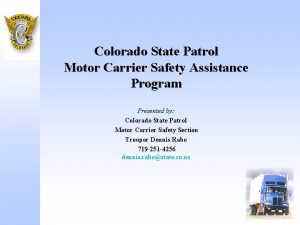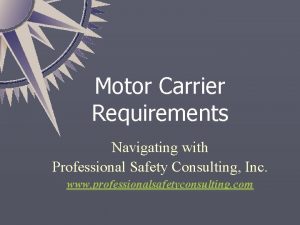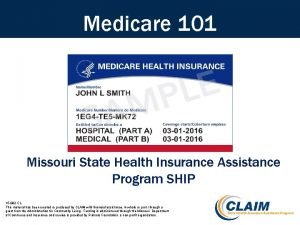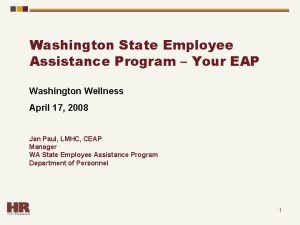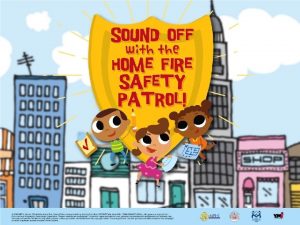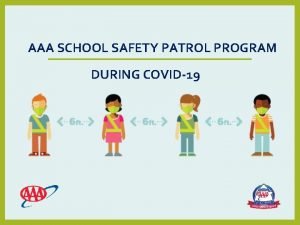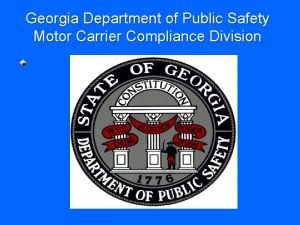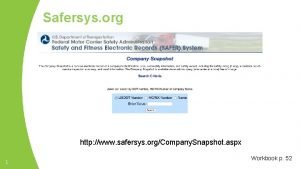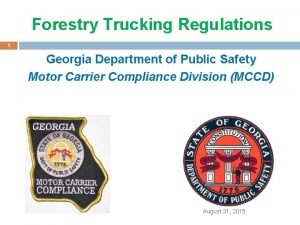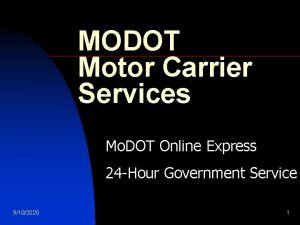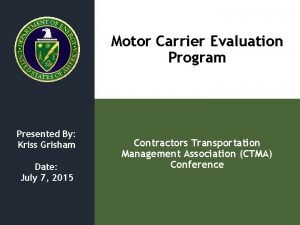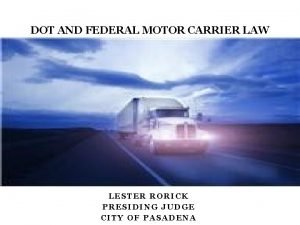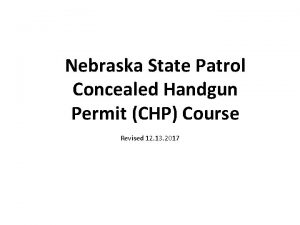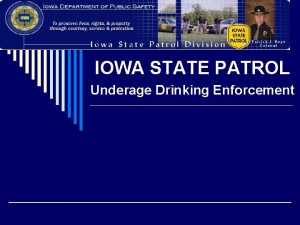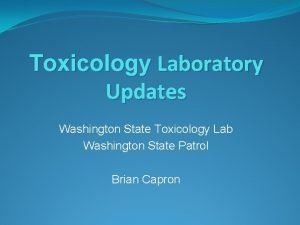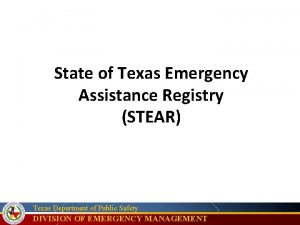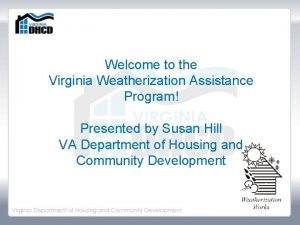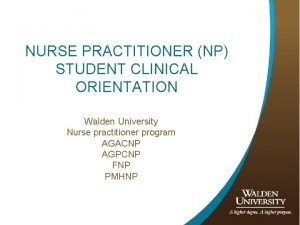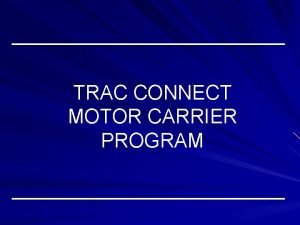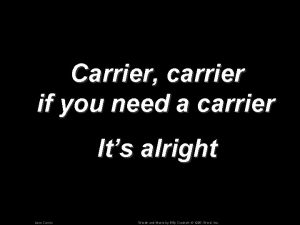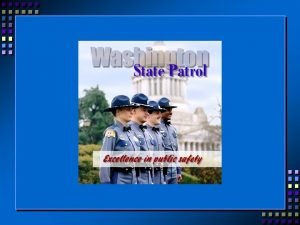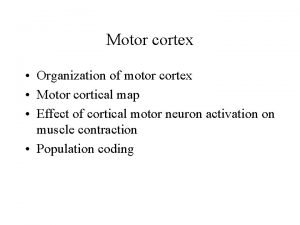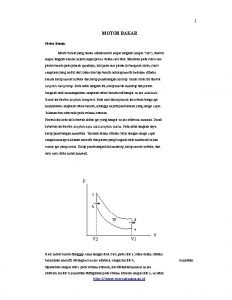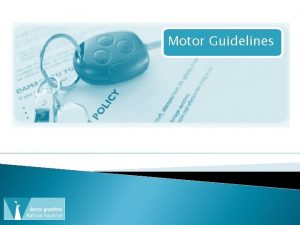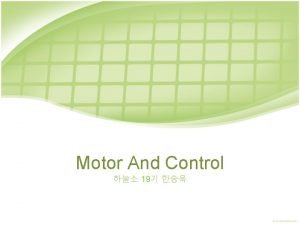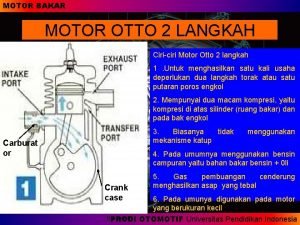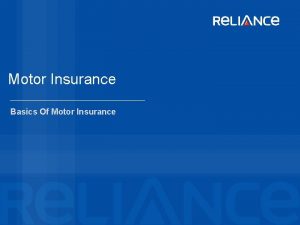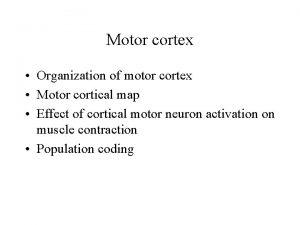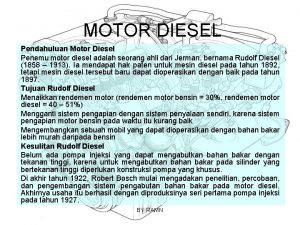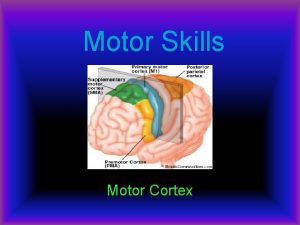Colorado State Patrol Motor Carrier Safety Assistance Program





















- Slides: 21

Colorado State Patrol Motor Carrier Safety Assistance Program Presented by: Colorado State Patrol Motor Carrier Safety Section Trooper Dennis Rabe 719 -251 -4256 dennis. rabe@state. co. us

General Rules Commercial Motor Vehicle (Interstate): § Any self-propelled or towed motor vehicle used on a highway in interstate commerce to transport passengers or property when the vehicle: § Has a gross vehicle weight rating or gross combination weight rating, or gross vehicle weight or gross combination weight, of 4, 536 kg (10, 001 pounds) or more, whichever is greater; or § Is designed or used to transport more than 8 passengers (including the driver) for compensation; or § Is designed or used to transport more than 15 passengers, including the driver, and is not used to transport passengers for compensation; or § Is used in transporting a quantity of hazardous material requiring placarding.

General Rules Commercial Motor Vehicle (Intrastate) 42 -4 -235: § Any self-propelled vehicle bearing an apportioned plate; § Having a manufacture’s gross vehicle weight rating (GVWR) or gross combination weight rating (GCWR) of at least 16, 001 pounds or more and used in commerce on public highways; or § Having a GVWR or GCWR of 16, 001 or more pounds and used to transport 16 or more passengers including the driver; or § Any motor vehicle designed or equipped to transport other motor vehicles from place to place by means of: winches, cables or pulleys or other equipment for towing, pulling or lifting when such motor vehicle is used in commerce. § Is used in transporting a quantity of hazardous material requiring placarding.

Compliance Review An on-site examination of motor carrier operations and transportation records to determine whether a motor carrier meets the safety fitness standard. Areas to be reviewed include: • • Drug and Alcohol Testing Commercial Drivers License Eligibility Financial Responsibility Driver Qualification Files Driving Motor Vehicles Records of Duty Status Vehicle Inspection and Maintenance

Commercial Driver’s License § With a Gross Vehicle Weight Rating (GVWR) or Gross Vehicle Weight (GVW) greater than 26, 001 pounds, or § Designed to transport at least 16 passengers including the driver; or § Transporting a quantity of hazardous materials requiring placarding.

Drug & Alcohol Testing § Drivers required to have a commercial drivers license (CDL) are subject to the controlled substance and alcohol testing rules. § This includes commercial motor vehicles operated by: • For-hire and private companies; • Federal, State, local, and tribal governments; • Church and civic organizations; • Apiarian industries.

Types of Drug & Alcohol Tests • • • Pre-employment Post-Accident Random Reasonable Suspicion Return-to-Duty Follow-up

Minimum Levels of Financial Responsibility § Financial responsibility means having insurance policies or surety bonds sufficient to satisfy the minimum public liability requirements. § Requirements for financial responsibility Motor carriers of property operating commercial motor vehicles in interstate, foreign, or intrastate commerce, and for-hire carriers of passengers operating in interstate or foreign commerce must have at least the minimum amount of insurance required by law.

Minimum Levels of Responsibility Part 387 § Example of Form MCS-90.

Accident Register Accident- An occurrence involving a commercial motor vehicle operating on a public road that results in at least one of the following: • A fatality, • Bodily injury to a person who, as a result of the injury, immediately receives medical treatment away from the scene of the accident, • Disabling damage to one or more motor vehicles, requiring the vehicle(s) to be towed or otherwise transported from the scene by a tow truck or other vehicle. www. csp. state. co. us

Vehicle Markings Every commercial motor vehicle operated by a motor carrier in interstate/intrastate commerce must be marked, on BOTH sides of vehicle, with the following: • The motor carrier’s name or trade name • The motor carrier’s identification number, preceded by “US DOT. ”

Driver’s Qualification File Every motor carrier must have a qualification file for each regularly employed driver. The file must include: • Driver’s application for employment • Inquiry to previous employers - 3 years, • Inquiry to state agencies - annually, • Annual review of driving record, • Annual driver’s certification of violations, • Driver’s road test certificate or equivalent, • Medical examination certificate.

Driving of Motor Vehicles Every motor carrier, and employees responsible for the management, maintenance, operation, or driving of commercial motor vehicles shall comply with the rules in this part: • Illness or fatigue • Drugs • Alcohol • Safe loading • Railroad crossing/ stopping • Seat belts • Emergency signals for stopped vehicles • Placement of warning devices • Radar detectors • Texting and driving and cell phone use.

Hours of Service of Drivers “Every motor carrier shall require every driver used by the motor carrier to record his/her duty status. ”

Hours of Service of Drivers This record of duty status may include log books, ELD, ABORD or short haul exemption. Information on the ELD requirements can be found on the FMCSA website.

Hours of Service of Drivers Short Haul Provision (100/150 mile radius) A driver is exempt from the requirements to maintain a logbook if: The motor carrier is claiming the short haul operation in Part 395. 1 (e). The motor carrier is claiming the property carrying commercial motor vehicle not requiring a CDL exemption in Part 395. 1(e)(2). **A motor carrier MUST meet all of the provisions outlined in the exemptions to claim them.

Inspection & Maintenance General requirements: § Every carrier shall systematically inspect, repair, and maintain all commercial motor vehicles under its control. Recordkeeping requirements: § Motor carriers must maintain the following information for every vehicle they have controlled for 30 days or more. § Identifying information, including company number, make, serial number, year, and tire size. § A schedule of inspections to be performed, including type and due date. § Inspection, repair, and maintenance records. § These records must be retained for one year at the location where the vehicle is garaged, and maintained for six months after the vehicle leaves the carrier’s control.

Roadside Inspection Reports Roadside inspection reports: § Any driver who receives a roadside inspection report must deliver it to the motor carrier. Certification of roadside inspection reports: § An official of the motor carrier is to examine the roadside inspection report and ensure that any violations or defects noted on the report are corrected, § Within 15 days after the inspection, the carrier must sign and then return it to the indicated address, § A copy must be retained for 12 months from the date of inspection.

Driver/Vehicle Inspection Reports Post-trip inspection report: § Drivers must prepare a daily written post-trip inspection report at the end of each driving day only if defects are discovered. § This report must cover at least the following parts and accessories: • • • Service brakes (including trailer brake connections) Parking (hand) brake Steering mechanism Lighting devices and reflectors Tires Horn Windshield wipers Rearview mirrors Coupling devices Wheels and rims Emergency equipment

Periodic Inspection: § Every commercial motor vehicle must be inspected at least once every 12 months. The original or a copy of the periodic inspection report must be retained by the motor carrier for 14 months from the report date. Inspector Qualifications: § Motor carriers must ensure that persons performing annual inspections are qualified. Inspectors must: § § § understand the inspection standards of Part 393 and Appendix G, be able to identify defective components, have knowledge and proficiency in methods, procedures, and tools.

Information § Colorado State Patrol Motor Carrier Safety (303) 273 -1875 § Federal Motor Carrier Safety Administration (720) 963 -3130 A complete Educational and Technical Assistance package entitled " A MOTOR CARRIER'S GUIDE TO IMPROVING HIGHWAY SAFETY" is available free on the FMCSA website at: www. colorado. gov/csp https: //www. fmcsa. dot. gov/safety/carrier-safety/motor-carriers-guideimproving-highway-safety
 Colorado state patrol motor carrier safety
Colorado state patrol motor carrier safety Fmcsr 396
Fmcsr 396 Missouri state health insurance assistance program
Missouri state health insurance assistance program Eap washington state
Eap washington state Home fire safety patrol
Home fire safety patrol Aaa safety patrol supplies
Aaa safety patrol supplies Georgia department of motor vehicle safety
Georgia department of motor vehicle safety Safer fmcsa company snapshot
Safer fmcsa company snapshot Georgia intrastate motor carrier registration
Georgia intrastate motor carrier registration Modot motor carrier services
Modot motor carrier services Modot motor carrier express
Modot motor carrier express Modot motor carrier express
Modot motor carrier express Nebraska state patrol concealed carry
Nebraska state patrol concealed carry Iowa state patrol districts
Iowa state patrol districts Washington state toxicology lab
Washington state toxicology lab Texas department of public safety
Texas department of public safety Virginia weatherization assistance program
Virginia weatherization assistance program Nehemiah down payment assistance
Nehemiah down payment assistance Meditrek walden
Meditrek walden Employee assistance program townsville
Employee assistance program townsville Atap nevada
Atap nevada Virginia law enforcement assistance program
Virginia law enforcement assistance program
